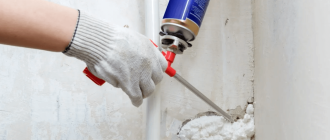When it comes to determining the right floor insulation R-value for your home, there are a few important factors to consider. The R-value is a measure of thermal resistance, or how well a material insulates against heat transfer. Proper insulation can help improve energy efficiency, reduce heating and cooling costs, and enhance overall comfort in your home.
Firstly, it’s important to understand that the recommended R-value for floor insulation can vary depending on your climate and the type of flooring you have. For example, homes in colder climates may require higher R-values to effectively keep out the cold air. On the other hand, homes in warmer climates may prioritize lower R-values to prevent heat from being trapped inside.
Another factor to consider is the location of your floors within your home. Different areas may have different insulation needs. For example, basement floors may require higher R-values due to their proximity to the ground, where cold air can penetrate. Similarly, floors above unheated spaces like garages or crawl spaces may also require additional insulation.
Ultimately, the right floor insulation R-value for your home will depend on a variety of factors, including your climate, flooring type, and the specific needs of different areas within your home. It’s always a good idea to consult with a professional insulation contractor who can assess your home and recommend the appropriate R-value for optimal energy efficiency and comfort.
#2 Understanding the Importance of Floor Insulation
When it comes to determining the right insulation for your home, don’t forget to consider the importance of floor insulation. Insulating your floors can have a significant impact on the comfort and energy efficiency of your home.
Improved Energy Efficiency: Proper floor insulation helps to prevent heat loss through the floors, which can result in significant savings on your energy bills. By creating a barrier between the cold ground and your home, floor insulation helps to maintain a comfortable temperature inside.
Enhanced Comfort: Insulating your floors can also improve the overall comfort of your home. Cold floors can make your home feel chilly and uncomfortable, especially during the winter months. With the right insulation, you can provide a cozy and warm environment for you and your family.
Noise Reduction: In addition to improving energy efficiency and comfort, floor insulation can also help reduce noise. It acts as a sound barrier, preventing sound from traveling between floors. This can be particularly beneficial if you have multiple levels in your home or live in a noisy neighborhood.
Types of Floor Insulation
There are several types of floor insulation to choose from, including:
- 1. Fiberglass batts or rolls: These are budget-friendly and easy to install options.
- 2. Spray foam insulation: This type of insulation provides excellent coverage and can reach tight spaces.
- 3. Rigid foam insulation: This insulation is durable and moisture resistant, making it suitable for areas prone to moisture.
It’s important to consider factors such as the R-value, cost, and installation requirements when selecting the right floor insulation for your home. Consulting with a professional insulation contractor can help you make an informed decision.
Overall, floor insulation plays a crucial role in maintaining a comfortable and energy-efficient home. Whether you are building a new home or considering upgrades, don’t underestimate the importance of insulating your floors.
#3 Factors to Consider When Choosing Floor Insulation
When determining the right floor insulation for your home, there are several factors that you need to consider. The insulation’s R-value plays a crucial role in determining its effectiveness in preventing heat transfer. However, the R-value alone is not the only consideration when choosing floor insulation. Here are three important factors to take into account:
1. Climate and Location
The climate and location of your home are significant factors in determining the right floor insulation. Different regions have different climate conditions, such as extreme temperatures and humidity levels, which affect the insulation requirements. For example, if you live in a cold climate, you will need insulation with a higher R-value to prevent heat loss. If you live in a hot and humid climate, you will need insulation that can resist moisture and maintain its R-value.
2. Material and Type of Insulation
The material and type of insulation you choose for your floor also play an important role in its overall effectiveness. There are various insulation materials available, including foam board, fiberglass, and cellulose, each with its own benefits and considerations. Foam board insulation, for example, offers excellent thermal resistance and moisture control, making it suitable for basements and crawlspaces. Fiberglass insulation is cost-effective and easy to install, while cellulose insulation is eco-friendly and provides sound insulation.
3. Installation and Cost
The installation process and cost are practical considerations when choosing floor insulation. Some insulation materials require professional installation, while others can be installed as a DIY project. The cost of the insulation also varies depending on the material, R-value, and installation requirements. Consider your budget and whether you have the necessary skills and tools for installation. It is essential to strike a balance between the performance and cost of the insulation.
By considering these factors, you can determine the right floor insulation for your home. It is crucial to choose insulation with the appropriate R-value, taking into account the climate, location, material, type, installation process, and cost. Properly insulated floors can help improve energy efficiency, reduce heating and cooling costs, and provide comfort throughout the year.
#4 How to Calculate the Right R-Value for Your Home
When determining the right insulation for your home, understanding the concept of R-value is crucial. R-value measures the ability of insulation to resist heat flow. The higher the R-value, the greater the insulating power. To calculate the right R-value for your home, follow these steps:
Step 1: Evaluate your climate
Firstly, consider the climate you live in. Different regions have different temperature variations, which affect the necessary level of insulation. For colder climates, a higher R-value is recommended to prevent heat loss. Warmer climates may require a lower R-value to keep the heat out.
Step 2: Assess your home’s structure
Next, assess your home’s structure, including the type of walls and floors you have, as well as the level of existing insulation. Different materials and constructions have varying levels of thermal resistance, impacting the recommended R-value.
Step 3: Determine desired energy efficiency
Consider your desired energy efficiency goals. Are you aiming for maximum energy savings or simply looking to meet the minimum insulation requirements? Adjust the R-value accordingly.
Once you have gathered this information, you can calculate the right R-value for your home using online calculators or consulting with insulation professionals. Just remember that the higher the R-value, the better the insulation, providing you with a more comfortable and energy-efficient home.
#5 Determining the Thermal Resistance Requirements
Determining the appropriate thermal resistance, or R-value, for your floor insulation is crucial when it comes to ensuring energy efficiency and maintaining a comfortable home environment. The R-value represents the material’s ability to resist heat transfer, with higher values indicating better insulation performance.
Factors to Consider
Several factors should be taken into account when determining the R-value requirements for your floor insulation. These factors include:
| Climate | The climate in your region will play a significant role in determining the appropriate R-value. Colder climates require higher R-values to provide adequate insulation against heat loss. |
| Type of Floor | The type of floor you have will also influence your insulation needs. Concrete slabs, for example, have different insulating requirements compared to suspended timber floors. |
| Usage of the Space | The way you use the space below your floor is another important consideration. If the area below is unoccupied and unheated, lower R-values may be acceptable. However, if it is used as a living or working space, higher R-values may be required. |
Consulting a Professional
Given the complexity of determining the optimal R-value for your floor insulation, it is recommended to consult with a professional insulation contractor or energy auditor. They can assess your specific home and provide expert advice on the right R-value based on factors such as the size and layout of your home, existing insulation, and your energy-saving goals.
By determining the appropriate R-value for your floor insulation, you can ensure optimal energy efficiency and maximize the comfort of your home all year round.
#6 Assessing the Climate and Local Building Codes
When determining the right floor insulation R-value for your home, it is essential to assess the climate in your region and familiarize yourself with the local building codes. Both of these factors can have a significant impact on the type and thickness of insulation you should choose.
The climate in your area will dictate the amount of heat loss or gain that occurs through the floor. If you live in a cold climate, with harsh winters and freezing temperatures, you will need a higher R-value to ensure adequate insulation. On the other hand, if you reside in a warm climate, you may require a lower R-value to prevent heat from entering your home.
Local building codes are regulations that dictate the minimum requirements for insulation in residential buildings. These codes are typically designed to ensure energy efficiency and occupant comfort. It is crucial to comply with these codes when selecting the right floor insulation, as failure to do so may result in fines or delays in obtaining necessary permits.
| Climate | Recommended R-value |
|---|---|
| Cold | R-Value 30-60 |
| Moderate | R-Value 20-30 |
| Hot | R-Value 10-20 |
Consulting with a local building professional or insulation contractor can help you determine the specific requirements for your area. They will have a thorough understanding of the climate and building codes and can recommend the right insulation type and R-value for your floor.
#7 Different Types of Floor Insulation Materials
When it comes to determining the right floor insulation R-value for your home, it is important to consider the different types of insulation materials available. Each material has its own characteristics and benefits, so it is crucial to choose the one that best suits your needs.
Fiberglass Insulation
Fiberglass insulation is one of the most common types of floor insulation materials. It is made from fine glass fibers and is available in batts or loose-fill form. Fiberglass insulation provides excellent thermal performance and is relatively affordable. It is also resistant to moisture and does not promote the growth of mold or mildew.
Cellulose Insulation
Cellulose insulation is another popular choice for floor insulation. It is made from recycled paper products and treated with fire-retardant chemicals. Cellulose insulation has excellent insulating properties and is resistant to pests. However, it is important to note that cellulose insulation may settle over time, reducing its effectiveness.
Spray Foam Insulation
Spray foam insulation is a versatile option for floor insulation. It is applied as a liquid and expands to fill gaps and crevices, providing a seamless and airtight barrier. Spray foam insulation has excellent insulating properties and can increase the structural integrity of your floor. However, it is generally more expensive than other types of insulation materials.
These are just a few examples of the different types of floor insulation materials available. It is important to consult with a professional insulation contractor to determine which material is best suited for your specific needs and budget. They will be able to assess your home’s insulation needs and recommend the right type and R-value for your floor insulation.
#8 Pros and Cons of Fiberglass Insulation
Fiberglass insulation is one of the most popular choices when it comes to insulating a home. It is made from molten glass that is spun into thin fibers, creating a fluffy material that can be easily installed in walls, ceilings, and floors. While fiberglass insulation has many benefits, it also has some drawbacks. In this section, we will explore the pros and cons of using fiberglass insulation in your home.
Pros
1. Cost-effective: Fiberglass insulation is generally more affordable than other types of insulation, making it a popular choice for homeowners on a budget.
2. Easy installation: Fiberglass insulation is lightweight and easy to handle, making it a straightforward DIY project for many homeowners.
3. Energy efficiency: Fiberglass insulation has a high R-value, meaning it provides excellent thermal resistance and can help reduce energy consumption and utility bills.
4. Fire-resistant: Fiberglass insulation is non-combustible and can help slow down the spread of fire, providing valuable time for evacuation in the event of an emergency.
5. Soundproofing: Fiberglass insulation can help reduce noise transmission, making it a great choice for rooms that require sound insulation, such as home theaters or bedrooms.
Cons
1. Susceptible to moisture: Fiberglass insulation can absorb and retain moisture, which can lead to mold and mildew growth if not properly protected or installed.
2. Prone to settling: Over time, fiberglass insulation may settle or compress, reducing its effectiveness and necessitating reinstallation or additional insulation.
3. Potential for skin irritation: Handling fiberglass insulation without proper protective equipment can cause skin irritation and respiratory issues for some individuals.
4. Limited lifespan: Fiberglass insulation may degrade over time, especially in high-moisture environments, and may need to be replaced sooner than other types of insulation.
5. Environmental concerns: The production process of fiberglass insulation involves the use of energy and resources, and the disposal of old fiberglass insulation can be challenging and contribute to landfill waste.
When determining the right insulation for your home, it’s important to consider both the pros and cons of different options. Fiberglass insulation offers many benefits, but it’s crucial to weigh them against any potential drawbacks and evaluate your specific needs and circumstances.
#9 Benefits and Drawbacks of Foam Insulation
Foam insulation is a popular choice for homeowners looking to improve the energy efficiency of their homes. It offers a range of benefits, but also comes with a few drawbacks to consider. Here are the key advantages and disadvantages of using foam insulation for your floors:
Benefits:
1. Energy efficiency: Foam insulation has a high R-value, meaning it provides excellent thermal resistance. This helps to keep your home warm in the winter and cool in the summer, reducing the need for heating and cooling systems.
2. Air sealing: Foam insulation forms a continuous and airtight barrier, reducing air infiltration and preventing drafts. This helps to maintain a comfortable indoor environment and improve indoor air quality.
3. Moisture resistance: Closed-cell foam insulation is impermeable to water, preventing moisture from seeping into your home. This can help to prevent mold and mildew growth, as well as damage from water leaks.
4. Soundproofing: Foam insulation has excellent sound absorption properties, reducing noise transfer between rooms. This can provide a quieter and more peaceful living environment.
Drawbacks:
1. Cost: Foam insulation tends to be more expensive than other insulation options, especially for larger areas.
2. Installation complexity: Foam insulation requires professional installation, as it involves specialized equipment and skills. Improper installation can lead to performance issues and wasted materials.
3. Environmental impact: Foam insulation materials may contain chemicals that can be harmful to the environment. It is essential to choose eco-friendly foam options if you have concerns about sustainability.
In conclusion, foam insulation offers significant benefits such as energy efficiency, air sealing, moisture resistance, and soundproofing. However, it is important to consider the potential drawbacks of cost, installation complexity, and environmental impact. Consulting with a professional insulation contractor can help you determine if foam insulation is the right choice for your home.
#10 Comparing the Efficiency of Spray Foam vs. Batt Insulation
When it comes to determining the right R-value for floor insulation, there are several options to choose from. Two popular choices are spray foam insulation and batt insulation. Both options have their own advantages and disadvantages, and it’s important to understand the differences between the two before making a decision.
Spray foam insulation is a versatile option that provides a high R-value per inch of thickness. It forms an airtight seal when applied, preventing air leakage and reducing energy loss. Spray foam insulation is ideal for sealing gaps and small crevices, making it a great option for homes with irregularly shaped or hard-to-reach areas. It also has soundproofing properties, reducing noise transmission between rooms. However, spray foam insulation can be expensive and may require professional installation.
Batt insulation, on the other hand, is a more affordable option that comes in rolls or batts. It is made of fiberglass or mineral wool fibers and is generally easy to install. Batt insulation is effective at reducing heat transfer and can be a good choice for standard-sized areas. It can be installed in a DIY fashion, which can save on installation costs. However, batt insulation may not provide as high of an R-value per inch compared to spray foam insulation, and it may not provide the same level of airtightness.
When comparing the efficiency of spray foam insulation and batt insulation, it’s important to consider the specific needs of your home. Factors such as the climate, budget, and accessibility of the area to be insulated should be taken into account. Additionally, consulting with a professional insulation contractor can provide valuable guidance and help in determining the best option for your specific situation.
In conclusion, both spray foam insulation and batt insulation have their own advantages and disadvantages. Spray foam insulation offers a high R-value and excellent airtightness but can be costly. Batt insulation is more affordable and easy to install but may not provide the same level of insulation. Ultimately, the choice between the two comes down to personal preference and the specific needs of your home.
Question and answer:
What is R-value and why is it important for floor insulation?
R-value is a measure of thermal resistance, indicating how well a material can resist heat flow. It is important for floor insulation because it determines the effectiveness of insulation in preventing heat loss or gain through the floor.
How do I determine the right R-value for the floor insulation in my home?
Determining the right R-value for floor insulation depends on factors such as climate, desired indoor temperature, and the type of heating and cooling system. Consulting with a professional or using online resources can help you determine the appropriate R-value for your specific circumstances.
What are the common R-values for floor insulation?
Common R-values for floor insulation range from R-13 to R-30, depending on the region and climate. Warmer areas typically require lower R-values, while colder regions may need higher R-values to ensure adequate insulation.
Can I add more insulation to increase the R-value of my existing floor insulation?
Yes, it is possible to add more insulation to increase the R-value of your existing floor insulation. This can be done by layering additional insulation materials or upgrading to a higher R-value insulation. However, it is important to consider the space available for insulation and consult with a professional to ensure proper installation.







